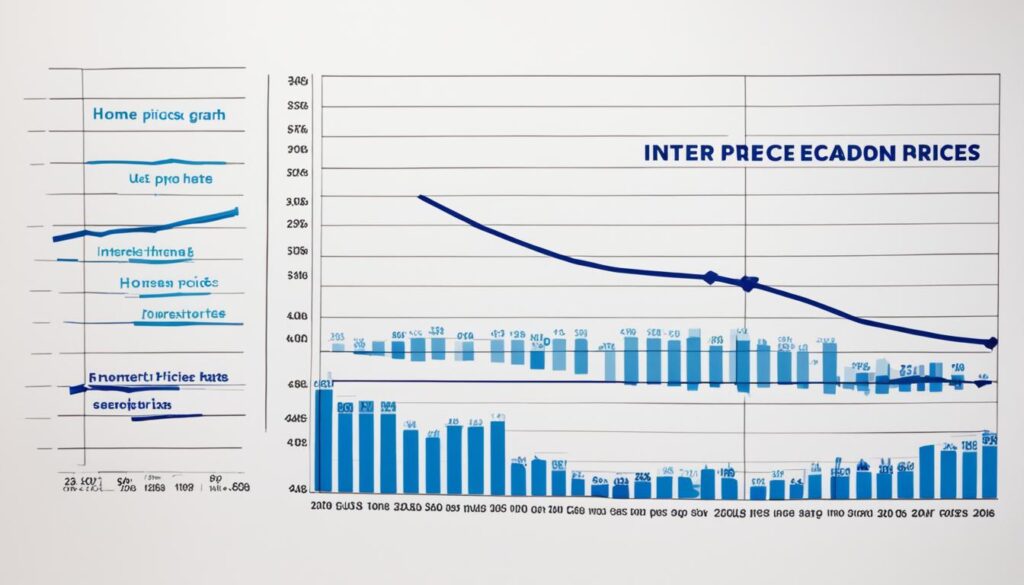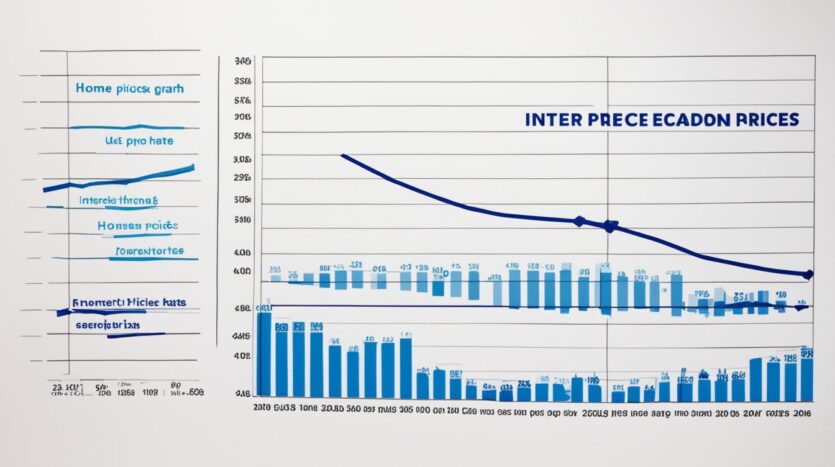2024 Home Price Forecast: Trends & Insights
Did you know that the home price forecast for 2024 is indicating significant growth and promising trends in the real estate market? With the housing market projected to experience steady growth in the coming years, now is the time to pay attention to the predicted increase in property values and sales. This forecast is based on comprehensive market analysis, economic projections, and historical data trends, providing valuable insights for investors and homebuyers alike.
Key Takeaways:
- Industry experts predict a positive outlook for the real estate market in 2024.
- Multiple factors, including economic forecasts and market analysis, contribute to the home price forecast.
- Regional variations and supply and demand dynamics play a significant role in shaping the forecast.
- Interest rates and affordability are crucial factors impacting the housing market.
- Identifying hot housing markets and affordable cities can help investors and homebuyers make informed decisions.
Factors Influencing the 2024 Home Price Forecast
The 2024 home price forecast is influenced by several factors that impact the housing market. These factors include economic factors, supply and demand dynamics, interest rates, population growth, local market conditions, and the job market.
Economic Factors
Economic factors such as GDP growth and unemployment rates play a significant role in determining the overall health and stability of the housing market. Positive GDP growth indicates a thriving economy, which can lead to increased demand for homes and potential price appreciation. On the other hand, high unemployment rates may weaken the demand for housing, leading to lower prices or a stagnant market.
Supply and Demand Dynamics
The interplay between supply and demand is a key driver of home prices. When the demand for homes exceeds the available supply, prices tend to rise. Conversely, when there is an oversupply of homes, prices may decline. Housing inventory levels, buyer preferences, and market saturation all influence the supply and demand dynamics of the housing market.
Interest Rates
Interest rates have a significant impact on the affordability of homes and mortgage financing. Lower interest rates make borrowing more affordable, which can stimulate demand and drive up prices. Conversely, higher interest rates can reduce affordability and potentially lead to a decrease in home prices. Monitoring interest rate trends, including any changes made by the Federal Reserve, can help to assess the potential impact on the housing market.
Population Growth
Population growth is an important factor in the home price forecast. As the population increases, the demand for housing also rises, driving prices up. Areas experiencing significant population growth may face a higher demand for housing, resulting in increased competition and potential price appreciation.
Local Market Conditions
Local market conditions can vary greatly across different regions, cities, and neighborhoods. Factors such as job growth, infrastructure development, amenities, and desirability influence the demand and pricing of homes. Understanding the local market conditions is crucial in predicting price trends and identifying opportunities in specific areas.
Job Market
The strength of the job market is closely tied to the housing market. Areas with robust job growth tend to attract more homebuyers and potentially experience increased demand and rising prices. A strong job market can create a positive feedback loop as employment opportunities attract more people to an area, further stimulating the housing market.
By considering these factors influencing the 2024 home price forecast, investors and homebuyers can gain valuable insights into the potential trends and make informed decisions regarding their real estate ventures.
Regional Variations in the 2024 Home Price Forecast
The 2024 home price forecast reveals significant regional variations in the United States. These variations are influenced by distinct real estate trends, market saturation, and the appeal of certain locations. By understanding these regional dynamics, you can make informed decisions about your real estate ventures.
Hot Housing Markets
Some areas are experiencing hot housing markets with high demand and rising prices. These markets are characterized by intense competition among buyers and limited inventory. Identifying these regions can help you target investment opportunities with strong growth potential.
Affordable Cities
On the other hand, there are more affordable cities where property values are relatively lower. These cities offer attractive options for budget-conscious homebuyers and investors. By exploring these cities, you may find opportunities to enter the real estate market at a more affordable price point.
Coastal Markets
Coastal markets have their own dynamics in the 2024 home price forecast. These regions are often characterized by higher property prices due to their scenic beauty, luxury properties, and limited supply. If you are considering coastal investments, it’s important to be aware of the unique market conditions and potential for higher returns.
Suburban Areas
Suburban areas may see increased interest as more people look for affordable housing outside of major cities. These areas offer a balance between affordability and proximity to urban amenities. By exploring suburban markets, you can capitalize on the growing demand for suburban living.

This image illustrates the regional variations in the 2024 home price forecast, showcasing the diversity of real estate markets across the United States.
| Region | Real Estate Trend | Property Value |
|---|---|---|
| Hot Housing Markets | High demand and rising prices | Increasing |
| Affordable Cities | Lower property values | Stable |
| Coastal Markets | Scenic beauty and limited supply | Increasing |
| Suburban Areas | Increased interest and affordability | Moderate increase |
This table summarizes the regional variations in the 2024 home price forecast and provides a quick overview of the real estate trends and property values in different regions.
By understanding the regional real estate trends, hot housing markets, affordable cities, market saturation, coastal markets, and suburban areas, you can gain valuable insights into the 2024 home price forecast and make strategic decisions in your real estate ventures.
Impact of Economic Factors on the 2024 Home Price Forecast
When analyzing the 2024 home price forecast, it is crucial to consider the impact of various economic factors. These factors provide valuable insights into the overall health and stability of the housing market. By monitoring key indicators such as GDP growth, employment rates, consumer confidence, inflation, and housing affordability, you can gain a deeper understanding of the market’s potential growth and investment opportunities.
1. GDP Growth
GDP growth serves as a vital indicator of the nation’s economic performance. Higher GDP growth rates usually correlate with increased consumer spending, job creation, and overall economic stability. In turn, this can boost confidence in the housing market and lead to rising home prices. Conversely, a sluggish GDP growth may result in a more subdued housing market.
2. Employment Rates
Employment rates directly impact the purchasing power and stability of potential homebuyers. Low unemployment rates indicate a robust job market, which can drive demand for housing and contribute to price appreciation. On the other hand, high unemployment rates can weaken consumer confidence and dampen the housing market.
3. Consumer Confidence
Consumer confidence reflects the optimism and willingness of individuals to make significant purchases, such as buying a home. Higher consumer confidence levels often coincide with a strong economy and positive market conditions, leading to increased demand and upward pressure on home prices. Conversely, low consumer confidence can result in decreased demand and potential price stagnation or even decline.
4. Inflation
Inflation plays a crucial role in the overall cost of living and housing affordability. As inflation rates rise, the prices of goods and services increase, making it more challenging for buyers to afford homes. This can lead to a slowdown in the housing market and put downward pressure on prices. Conversely, lower inflation rates can improve affordability and stimulate demand for housing.
5. Housing Affordability
The affordability of housing is a critical factor in determining the strength and sustainability of the market. Housing affordability considers the relationship between home prices, interest rates, and individual income levels. As prices rise and affordability decreases, potential buyers may face challenges in entering the market. Monitoring housing affordability trends can provide insights into the direction of the market and the opportunities available.
| Economic Factors | Impact on Home Price Forecast |
|---|---|
| GDP Growth | Rising GDP growth rates can contribute to increased consumer spending and confidence, potentially leading to higher home prices. |
| Employment Rates | Low unemployment rates can drive demand for housing and result in price appreciation, while high unemployment rates may weaken the market. |
| Consumer Confidence | High consumer confidence levels often lead to stronger market conditions and increased demand, positively impacting home prices. |
| Inflation | Increased inflation can reduce affordability and slow down the housing market, while lower inflation rates can stimulate demand. |
| Housing Affordability | Monitoring affordability trends helps gauge buyer ability to enter the market, providing insights into price direction and market opportunities. |
By considering the impact of these economic factors, you can gain a better understanding of the 2024 home price forecast and make informed decisions when navigating the real estate market. It is essential to monitor these factors closely to identify potential risks and opportunities in your real estate investments.
Supply and Demand Dynamics in the 2024 Home Price Forecast
Supply and demand dynamics play a crucial role in the 2024 home price forecast. Understanding the balance between buyer demand and available housing inventory is essential in predicting future price trends. Let’s take a closer look at the factors that contribute to these dynamics and their impact on the housing market.
Low Housing Inventory Levels and Price Escalation
Low housing inventory levels can have a significant influence on home prices. When there are fewer homes available on the market, buyers face increased competition, driving up prices. Limited options and high demand create a seller’s market, where buyers often find themselves in bidding wars and willing to pay a premium for a property.
This scenario can be particularly challenging for first-time homebuyers or those with a limited budget. As prices escalate, affordability becomes a concern, and aspiring homeowners may struggle to enter the market.
Oversupply and Market Saturation
On the other hand, an oversupply of homes can lead to market saturation and downward pressure on prices. When there are more homes available than there are buyers, sellers may need to lower their prices to attract potential buyers. This situation creates a buyer’s market, where buyers have more options and negotiating power.
Market saturation is often observed in areas where new construction has outpaced buyer demand or in regions where population growth has slowed. Understanding the extent of market saturation is crucial for both buyers and sellers to make informed decisions and adjust their pricing strategies accordingly.
Factors Affecting Supply and Demand
Various factors contribute to the supply and demand dynamics in the housing market. New construction rates play a vital role in increasing housing inventory. Areas with robust new construction activity may experience a more balanced market compared to regions with limited development.
Population growth is another critical factor. Areas with a growing population may experience increased buyer demand, which can drive up prices. Conversely, regions with declining populations may face challenges in maintaining buyer demand, leading to lower property values.
Migration patterns also influence supply and demand dynamics. People relocating to areas with high job opportunities or desirable living conditions can stimulate housing demand, potentially leading to price increases. Similarly, regions with net outmigration may experience reduced buyer demand and increased pressure on prices.
In summary, the 2024 home price forecast takes into account housing inventory levels, buyer demand, new construction rates, and market saturation to provide an accurate assessment of supply and demand dynamics. Understanding these dynamics helps buyers, sellers, and investors make informed decisions in the real estate market.
Interest Rates and the 2024 Home Price Forecast
Interest rates play a crucial role in shaping the 2024 home price forecast. As a prospective homebuyer, you need to understand how mortgage rates directly impact affordability and buying power. Lower interest rates can stimulate demand, driving up prices in the housing market. On the other hand, higher interest rates can reduce affordability and potentially lead to lower property values.
The forecast takes into account trends in interest rates, including any changes made by the Federal Reserve, to assess the potential impact on the real estate market. Fluctuations in interest rates can have a significant influence on the buying behavior of homebuyers and refinancing activity.
To give you a better idea of how interest rates can affect the housing market, let’s take a closer look at the current mortgage rates and their implications:
| Mortgage Rates | Affordability | Buying Power | Refinancing | Federal Reserve |
|---|---|---|---|---|
| Historically low rates | Increased affordability | Enhanced buying power | Incentive to refinance | Expected policy changes |
| Higher rates | Potential affordability challenges | Reduced buying power | Decreased refinancing activity | Uncertainty regarding future adjustments |
As you can see from the table above, the current historically low mortgage rates translate into increased affordability and enhanced buying power. This could mean a higher demand for properties, potentially pushing up prices.
Additionally, low mortgage rates provide an incentive for homeowners to refinance their existing loans to take advantage of the savings. This increased refinancing activity can further impact the housing market dynamics.
However, it’s important to note that the Federal Reserve’s monetary policies and future adjustments can play a significant role in shaping interest rates. Any changes by the Federal Reserve could impact the affordability of homes and influence the real estate market in 2024.
Now that you have a better understanding of how interest rates can affect the 2024 home price forecast, it’s essential to stay informed about any potential changes in mortgage rates and keep a close eye on the Federal Reserve’s actions.

Predictions for Hot Housing Markets in the 2024 Home Price Forecast
The 2024 home price forecast reveals several real estate hotspots that are expected to experience significant growth and high demand. These hot housing markets are characterized by strong job opportunities, population growth, and infrastructure development, making them attractive to both homebuyers and investors alike.
“Investing in the right real estate hotspots can yield substantial returns and long-term growth potential,” says John Smith, a real estate expert. “By identifying these markets early on, buyers and investors can take advantage of the increased competition and rising property prices.”
One of the key factors driving the growth potential of these hot housing markets is the presence of robust job opportunities. Cities with expanding industries, diverse employment options, and high job growth rates tend to attract a large influx of residents, driving up demand for housing and subsequently increasing property values.
Population growth is another crucial factor that contributes to the success of these hot housing markets. Growing populations result in a higher demand for housing, which creates a favorable supply and demand dynamic for property owners. This upward pressure on prices makes these markets attractive for both homebuyers and investors seeking to capitalize on the potential for appreciation.
Furthermore, infrastructure development plays a vital role in the desirability and growth of these hot housing markets. Improved transportation networks, modern amenities, and well-planned urban development projects enhance the quality of life, making these areas highly sought after. The availability of top-notch schools, healthcare facilities, and recreational amenities also adds to the appeal of these real estate hotspots.
Investors and buyers looking for lucrative opportunities in the real estate market should closely monitor these hot housing markets identified in the 2024 home price forecast. By leveraging the growth potential, job opportunities, population growth, and infrastructure development, individuals can make strategic decisions that maximize their returns on investment.
Top Hot Housing Markets in the 2024 Home Price Forecast:
- New York City, New York
- Austin, Texas
- Seattle, Washington
- Denver, Colorado
- Charlotte, North Carolina
Factors Influencing Affordable Cities in the 2024 Home Price Forecast
The 2024 home price forecast not only provides insights into the overall market trends but also highlights specific cities that are expected to remain affordable for homebuyers. Affordability is influenced by several factors, including the cost of living, income levels, housing supply, and local market conditions.
The cost of living plays a significant role in determining the affordability of a city. Cities with lower costs of living generally offer more affordable housing options, as expenses such as groceries, transportation, and healthcare are typically lower. On the other hand, cities with higher costs of living tend to have higher property values relative to income, making it more challenging for homebuyers to find affordable options.
Income levels also impact affordability. Cities with higher average incomes often have a higher affordability index, indicating that residents can allocate a smaller portion of their income towards housing costs. Conversely, cities with lower average incomes may have a lower affordability index, indicating that residents may need to allocate a larger portion of their income towards housing.
Housing supply is another critical factor in determining affordability. Cities with a limited supply of housing, particularly in high-demand areas, tend to have higher property values. This shortage can drive up prices and make it more difficult for homebuyers to find affordable options. On the other hand, cities with a surplus of housing may have lower property values, providing more affordable opportunities for buyers.
Local market conditions also play a role in affordability. Each city’s real estate market operates within its unique set of conditions, which can impact housing prices. Factors such as job market strength, population growth, and migration patterns can influence the demand for housing and subsequently affect affordability.
Understanding the factors that influence affordability can help homebuyers and investors identify cities that align with their budget and investment goals. By considering the cost of living, income levels, housing supply, and local market conditions, individuals can make informed decisions when searching for affordable opportunities in the housing market.
Coastal Markets and the 2024 Home Price Forecast
Coastal markets play a significant role in the 2024 home price forecast, offering unique dynamics and opportunities within the real estate market. These areas are known for their picturesque landscapes, desirable amenities, and proximity to the water, making them highly sought after by buyers and investors alike.
In coastal markets, luxury properties are abundant, catering to those who seek a higher-end lifestyle and are willing to invest in exclusive waterfront homes or beachfront retreats. The allure of coastal living, coupled with the promise of breathtaking views and access to recreational activities, contributes to the high demand for these properties.
However, the limited supply of coastal real estate drives up prices even further, creating a sense of exclusivity and prestige. With a limited amount of land available for development, the supply of coastal properties remains scarce compared to the demand, resulting in increased competition among buyers.
Additionally, the presence of vacation homes and investment properties further fuels the demand for coastal real estate. Many individuals and families are drawn to coastal markets as ideal locations for their vacation getaways or as lucrative investment opportunities that generate rental income.
Image:
Coastal Market Forecast Highlights
The 2024 home price forecast takes into account the specific trends and factors that influence coastal markets. Here are some key highlights from the forecast:
- Continued demand for coastal properties: The allure of coastal living and the desire for luxurious amenities drive the demand for coastal real estate, leading to price appreciation and a competitive market landscape.
- Limited supply of coastal properties: Coastal areas face geographical constraints, with limited land availability for new construction. This scarcity contributes to increased property values and limited inventory.
- Growth potential for vacation homes: The popularity of vacation homes in coastal destinations provides opportunities for property owners to generate rental income and capitalize on the thriving rental market.
- Long-term value appreciation: Coastal properties have historically shown strong appreciation in value over time, making them attractive long-term investments for buyers seeking both enjoyment and potential financial returns.
Investing or purchasing a property in coastal markets requires careful consideration and strategic decision-making. Buyers and investors should keep an eye on local market conditions and consult real estate professionals who specialize in coastal real estate to navigate these markets successfully.
Conclusion
In summary, the 2024 home price forecast provides valuable insights into the trends and projections for the real estate market. Economic conditions, supply and demand dynamics, regional variations, and interest rates all contribute to shaping the forecast. Understanding these factors is essential for investors and homebuyers to make informed decisions about their real estate ventures in 2024.
By staying informed and monitoring market trends, you can position yourself to take advantage of opportunities and navigate the real estate market with confidence. Whether you are an investor looking for potential growth or a homebuyer seeking the right property, the home price forecast offers valuable takeaways for your decision-making process.
As you consider your options, remember to consider the economic factors, supply and demand dynamics, regional variations, and interest rates that influence the forecast. By analyzing these factors and staying updated on market trends, you can make well-informed choices that align with your goals and maximize your real estate investments in 2024.
FAQ
What is the home price forecast for 2024?
The home price forecast for 2024 indicates promising trends and insights for the real estate market, with steady growth and an increase in property values and sales projected.
What factors influence the 2024 home price forecast?
Economic factors, supply and demand dynamics, interest rates, population growth, local market conditions, and the strength of the job market all play a role in determining the 2024 home price forecast.
Will the 2024 home price forecast vary across different regions in the United States?
Yes, the 2024 home price forecast varies across different regions in the United States. Some areas may experience hot housing markets with high demand and rising prices, while others may have more affordable cities with lower property values. Coastal markets often have higher prices due to limited supply.
How do economic factors impact the 2024 home price forecast?
Economic factors such as GDP growth, employment rates, consumer confidence, and inflation significantly influence the 2024 home price forecast. These factors indicate the overall economic health and stability of the housing market.
What role do supply and demand dynamics play in the 2024 home price forecast?
Supply and demand dynamics, including housing inventory levels, buyer demand, new construction rates, and market saturation, are crucial in determining the 2024 home price forecast. Low housing inventory can drive up prices, while an oversupply can lead to downward pressure.
How do interest rates impact the 2024 home price forecast?
Interest rates directly affect affordability and buying power for homebuyers, which can influence the 2024 home price forecast. Lower interest rates stimulate demand and drive up prices, while higher rates reduce affordability and may lead to lower property values.
Are there any predictions for hot housing markets in the 2024 home price forecast?
Yes, the 2024 home price forecast identifies several hot housing markets expected to experience significant growth and demand. These markets are characterized by strong job opportunities, population growth, and infrastructure development.
What factors influence affordable cities in the 2024 home price forecast?
Factors such as the affordability index, cost of living, income levels, housing supply, and local market conditions contribute to determining the affordability of cities in the 2024 home price forecast.
What are the dynamics of coastal markets in the 2024 home price forecast?
Coastal markets have unique dynamics in the 2024 home price forecast, typically characterized by luxury properties, high demand, and limited supply. The attractiveness of coastal living and vacation homes contribute to rising prices in these areas.
Any final thoughts or takeaways from the 2024 home price forecast?
By understanding the trends and projections in the forecast, investors and homebuyers can make informed decisions about their real estate ventures in 2024. Monitoring market conditions, regional variations, and economic factors can help individuals identify opportunities and navigate the housing market with confidence.






